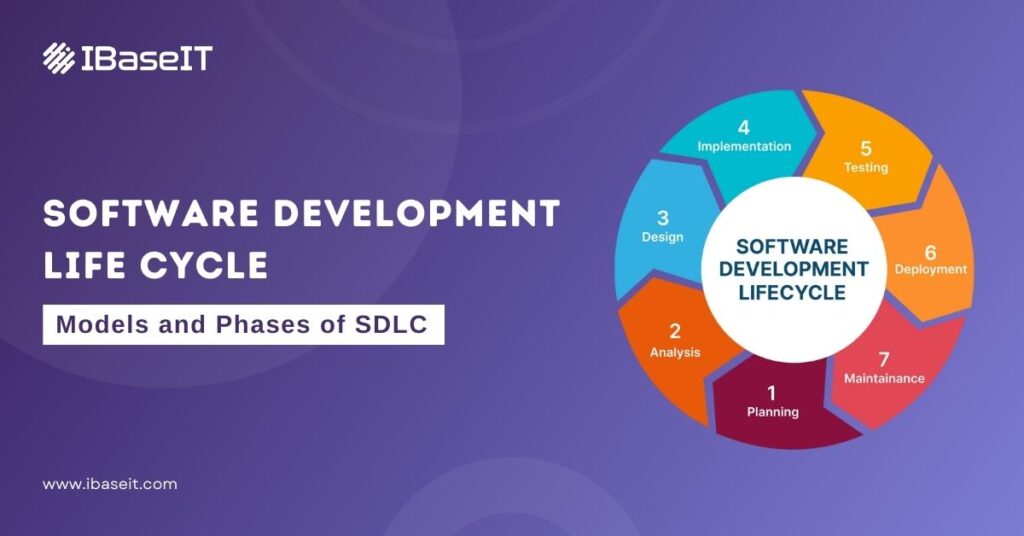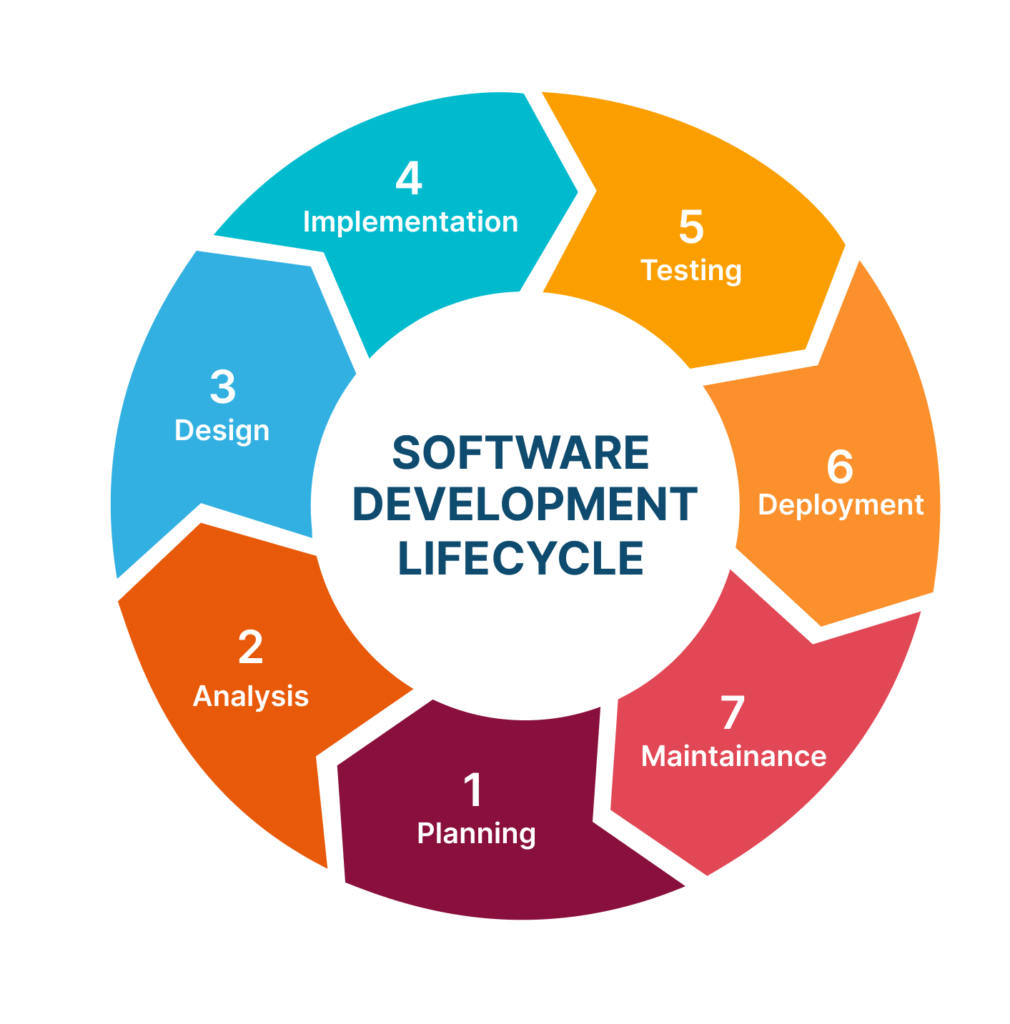
Introduction:
In today’s digital age, software programs are universal, powering everything from smart devices to complex company procedures. But have you ever thought about how these technological wonders come to life and continue to grow invisibly? It is an arduous journey of software development that’s rigorously guided by the software development life cycle. In this blog, we’ll delve into a step-by-step guide to developing software, from its definition and understanding to methodologies and benefits.
What is the Software Development Life Cycle (SDLC)?
The software development lifecycle (SDLC) is a time- and cost-effective procedure used by development groups to design and construct high-quality software. This is a methodical approach to creating, developing, and upkeep of software applications. It includes all processes and actions required to turn a notion into a working piece of software. The major goal of SDLC is to guarantee that software is built effectively, meets the requirements, is of superior quality, and is sustainable throughout its lifespan.
SDLC’s significance stems from its capacity to improve software quality, minimize development costs, and eliminate risks. Developers may verify that software satisfies user needs, performs reliably, and is delivered on time and within budget by adhering to a specified SDLC. SDLC also promotes enhanced interaction and cooperation among development teams, stakeholders, and users, resulting in a better understanding of project objectives. Furthermore, SDLC aids with early detection and resolution of difficulties, lowering the chance of costly mistakes and post-production faults. Overall, SDLC is critical for guaranteeing effective and efficient software application development while reducing risks and optimizing the quality of the software.
Benefits of Software Development Process
Software Development Life Cycle is a methodological process to develop, test, deploy, and manage software systems. Following an SDLC technique in software development has an array of benefits:
- Structured Approach: SDLC offers a disciplined and well-organized approach to software development. It divides the whole process into different phases, allowing the project to be simpler to lead and oversee.
- Quality Assurance: SDLC spotlights testing and quality assurance throughout the project, helping to identify and rectify defects early which can lead to a reliable product.
- Cost control: SDLC helps in controlling the cost of development, by defining the project scope, resources, and timeline upfronts. It also helps in reducing the chances of unexpected expenses and delays.
- Effective communication: Effective communication is the key to success, and this can be done with the help of SDLC, it promotes clear communication between the team, clients, and stakeholders ensuring that everyone is on the same page respecting project goals and progress.
- Better planning: Having a better plan for the project can help reduce the scope creep and budget runs. Following SDLC can uplift thorough project planning including explaining the project requirements, resource estimation, and even creating a project schedule.
- Flexibility: Few SDLC models are flexible and can adapt to changing requirements allowing a responsive approach to customer needs.
- Customer Satisfaction: SDLC thrives on delivering products that meet customer requirements. Agile approaches involve frequent feedback and gradual advancement to guarantee that the final product satisfies the demands of the users.
- Maintenance and support: The software development life cycle involves post-development maintenance and support, ensuring the software stays functional and can be updated as per the requirements and changes in technology.
Understanding the Software Development Process
SDLC refers to the process through which a group of software developers and engineers creates and maintains a software system. Starting with the notion of generating software and carrying it till it quits is all associated with the process. SDLC offers a disciplined way of developing software, guaranteeing that it satisfies objectives, is of excellent quality, and delivers on time and budget. Simply, understanding the process of software development involves software product discovery, creation, evaluation, and deployment.
Understanding this software process can be easy with the help of software development life cycle models as they serve as descriptive representations of the complete software development process.
Models Of Software Development Process
SDLC models are systematic methods of software development that explain the procedures and phases involved in the creation, testing, and maintenance of software applications. These models assist businesses in managing and controlling the development process, assuring that projects are finished on time and under budget while fulfilling quality and functionality standards. Here are a few common SDLC models:
1. Waterfall Model
This model is a liner sequential model, where the structures stage repeatedly, with the completion of each stage serving as the requirement for the next. The design under the conceptual structure moves sequentially from one stage to the next, resembling the ongoing motion of a waterfall.
This model consists of distinct phases, including requirements gathering, design, implementation, testing, deployment, and maintenance.
Pros
- Structured and clear.
- Simple to handle and plan.
Cons:
- Lack of adaptability to change.
- Keep consumer participation to a minimum until the end of the procedure.
2. Agile Model
The SDLC phases are divided into numerous development cycles in the agile paradigm. The team moves quickly through the various stages, producing only minor, progressive improvements to the software in every phase. They constantly assess needs, strategies, and outcomes to adjust swiftly to change. Because the agile approach is iterative and progressive, it is more effective than other models.
Pros
- Flexibility to changing requirements.
- High involvement of customers throughout the process.
Cons:
- This model may require an experienced team.
- Documentation can be restricted.
3. V-Model
This model is an extension of the waterfall model. In this model of SDLC, the process stages are bent upwards after implementation and coding forming a V-shape. This model highlights the relation between each development stage and the corresponding stage.
Pros
- Simple and easy to use
- Clear verification and validation process
- Higher chances of success than the waterfall model
Cons:
- Unresponsive to changes in requirements
- May not accommodate all the project types
- Expensive and time-consuming
4. Iterative Model
This SDLC model divides the process of software development into smaller and manageable iterative, each consisting of its own set of stages including project requirements, design, implementation, and testing.
Pros
- Easy to identify and manage risks
- Effortless adoption of evolving project requirements
Cons:
- Managing several iterations may be difficult.
- This model might lengthen the development process.
5. Spiral Model
To prioritize risk analysis, this SDLC model combines the small, repeated cycles of an iterate model with the linear sequential flow of a waterfall model. In this model, the projects are divided into cycles, with each of the 4 stages including planning, risk evaluation, engineering, and analysis.
Pros
- Risk management that works.
- The iterative technique allows for modifications.
Cons:
- It might be time-consuming.
- Complex and skilled project management is required.
6. Big Bang Model
This SDLC model is an informal and less organized method that focuses on development and performs best for small projects.
Pros
- Quick project start-up.
- Small, experimental initiatives require flexibility.
Cons:
- Uncertainty and risk abound.
- Lack of paperwork and control.
7. Rapid Application Development Model
This SDLC Model is primarily concerned with rapid prototyping and stakeholder interaction for rapid development.
Pros
- Quick development and feedback.
- High levels of consumer satisfaction.
Cons:
- Not suitable for complicated tasks.
- Skilled developers may be required.
7 Stages of the Software Development Process
The Software Development Life Cycle (SDLC) is divided into phases that guide the development process from the initial concept to the final product. These phases guarantee that software is produced in a methodical, high-quality manner that satisfies the needs of stakeholders. The titles and number of phases might vary based on the model or approach utilized, but below are seven common phases.

- Planning: During this first phase, the project’s goals, requirements, scope, and constraints are specified. This phase includes collecting information, performing feasibility studies, and developing a project plan that describes the project’s timetable, budget, and resources.
- Feasibility Phase: This phase includes an evaluation of the feasibility of the entire project including technical, operational, and financial assessments. This phase assists in making an educated choice on whether or not to proceed with the project.
- Designing: During this stage, the whole system’s design is developed. This comprises specifying the structure, components, modules, and their connections in the software. The user interfaces, database structure, and other technical components of the software may also be specified in the design.
- Implementation or coding: This is the location where the software is really coded. The source code is written by developers according to the design specifications. To guarantee that the code is accessible and efficient, optimal procedures and code guidelines are followed.
- Testing: Following coding, the program is tested to detect and remedy errors, as well as to confirm that it satisfies the defined criteria and operates as intended. Various forms of testing, including unit testing, integration testing, system testing, and user acceptability testing, are carried out at this phase.
- Deployment: Once the software is tested and validated thoroughly, it is deployed to a production environment, where installation, configuration, data migration, and training for end-users are included.
- Maintenance and Support: Here comes the final phase, once the software is deployed, it enters the maintenance stage. In this stage, all the updates, patches, and enhancements are developed to address issues, enhance performance, and modify the changes in the needs.
Conclusion
Software Development Life Cycle (SDLC) is the digital era’s backbone, managing the birth, development, and sustainability of the software programs that create our world. We’ve traveled through its basic components, from comprehending the SDLC’s essence to analyzing its methodology and deconstructing the seven critical stages. The SDLC is clearly more than a procedure; it is an approach that ensures software is built effectively, meets demands, maintains quality, and progresses smoothly over time. As you begin your software development journey, keep in mind that selecting the correct strategy and methodology can either make or break the efficacy of your project. As a result, understanding the SDLC is critical for navigating the complicated landscape of software development.
Are you looking for a trusted partner for your software development journey? IBaseIT boasts a track record of excellence in providing top-tier software development services. With a proven track record, a team of seasoned professionals, and a commitment to excellence, IBaseIT is your ideal choice. Why late? Contact our experts today and take your software projects to new heights.